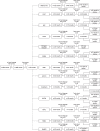Immunohistochemical markers of prognosis in adult granulosa cell tumors of the ovary - a review
- PMID: 36869369
- PMCID: PMC9983179
- DOI: 10.1186/s13048-023-01125-1
Immunohistochemical markers of prognosis in adult granulosa cell tumors of the ovary - a review
Abstract
Background: Granulosa cell tumors (GCT) are rare malignant ovarian tumors. The two subtypes, adult and juvenile granulosa cell tumors, differ in clinical and molecular characteristics. GCT are low-malignant tumors and are generally associated with favorable prognosis. However, relapses are common even years and decades after diagnosis. Prognostic and predictive factors are difficult to assess in this rare tumor entity. The purpose of this review is to provide a comprehensive overview of the current state of knowledge on prognostic markers of GCT to identify patients with a high risk of recurrence.
Methods: Systematic research for adult ovarian granulosa cell tumors and prognosis revealed n = 409 English full text results from 1965 to 2021. Of these articles, n = 35 were considered for this review after title and abstract screening and topic-specific matching. A specific search for pathologic markers with prognostic relevance for GCT identified n = 19 articles that were added to this review.
Results: FOXL2 mutation and FOXL2 mRNA were inverse and immunohistochemical (IHC) expression of CD56, GATA-4 and SMAD3 was associated with reduced prognosis. IHC analysis of estrogen receptor, Anti-Mullerian hormone (AMH) and inhibin was not associated with prognosis for GCT. Analyses of mitotic rate, Ki-67, p53, β-catenin and HER2 revealed inconsistent results.
Keywords: Adult granulosa cell tumor; Immunohistochemistry; Ovary; Prognosis.
© 2023. The Author(s).
Conflict of interest statement
The authors declare no competing interests.
Figures
Similar articles
-
Mutational analysis of FOXL2 p.C134W and expression of bone morphogenetic protein 2 in Japanese patients with granulosa cell tumor of ovary.J Obstet Gynaecol Res. 2014 May;40(5):1197-204. doi: 10.1111/jog.12324. Epub 2014 Apr 2. J Obstet Gynaecol Res. 2014. PMID: 24689977
-
Prognostic significance of FOXL2 mutation and mRNA expression in adult and juvenile granulosa cell tumors of the ovary.Mod Pathol. 2011 Oct;24(10):1360-7. doi: 10.1038/modpathol.2011.95. Epub 2011 May 27. Mod Pathol. 2011. PMID: 21623383
-
Transformation in recurrent ovarian granulosa cell tumors: Ki67 (MIB-1) and p53 immunohistochemistry demonstrates a possible molecular basis for the poor histopathologic prediction of clinical behavior.Hum Pathol. 1996 Mar;27(3):274-81. doi: 10.1016/s0046-8177(96)90069-6. Hum Pathol. 1996. PMID: 8600043
-
Molecular pathogenesis of granulosa cell tumors of the ovary.Endocr Rev. 2012 Feb;33(1):109-44. doi: 10.1210/er.2011-0014. Epub 2012 Jan 12. Endocr Rev. 2012. PMID: 22240241 Review.
-
[Recurrence occurring ten years after the initial diagnosis of granulosa cell tumour of the ovary: about two cases and review of the literatur].Pan Afr Med J. 2016 Sep 27;25:30. doi: 10.11604/pamj.2016.25.30.10433. eCollection 2016. Pan Afr Med J. 2016. PMID: 28154722 Free PMC article. Review. French.
Cited by
-
Risk Factors and Clinical Outcomes of Recurrence in Adult Ovarian Granulosa Cell Tumors.Cancer Rep (Hoboken). 2024 Oct;7(10):e70036. doi: 10.1002/cnr2.70036. Cancer Rep (Hoboken). 2024. PMID: 39453686 Free PMC article.
-
DNA alterations in ovarian adult granulosa cell tumours: A scoping review protocol.PLoS One. 2024 Jun 14;19(6):e0303989. doi: 10.1371/journal.pone.0303989. eCollection 2024. PLoS One. 2024. PMID: 38875223 Free PMC article.
-
Pathohistological Findings after Bilateral Ovariectomy in Mares with Behavioral Problems.Animals (Basel). 2024 Oct 8;14(19):2899. doi: 10.3390/ani14192899. Animals (Basel). 2024. PMID: 39409848 Free PMC article.
References
Publication types
MeSH terms
LinkOut - more resources
Full Text Sources
Medical
Research Materials
Miscellaneous


